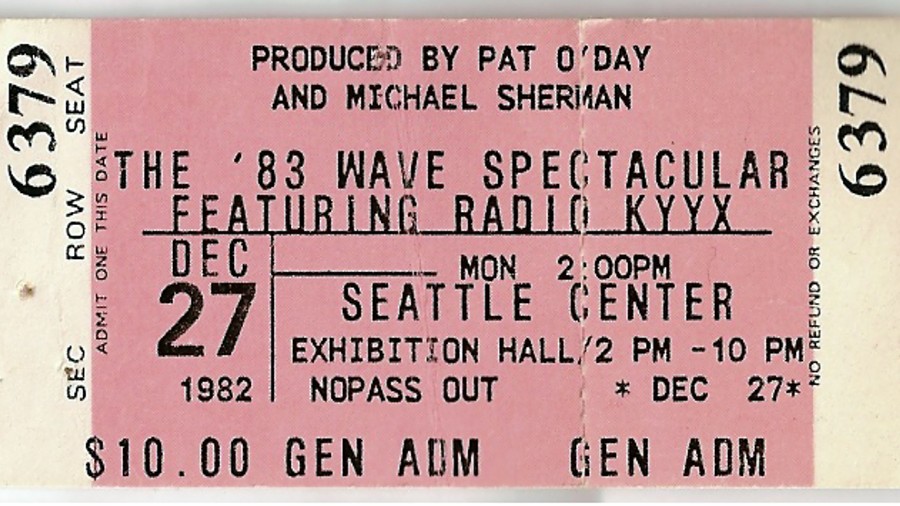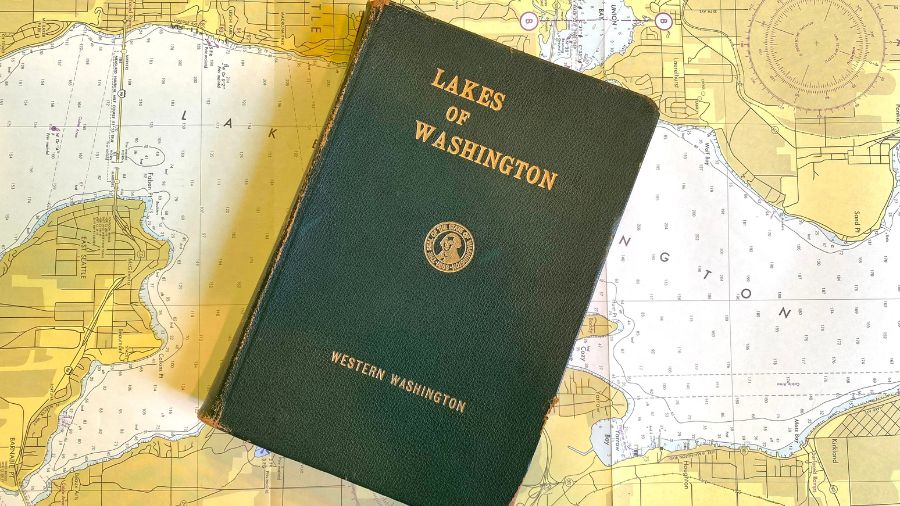Seattle event 40 years ago was a ‘New Wave boat show’
Jan 4, 2023, 11:42 AM | Updated: 11:57 am

A ticket stub from the WAVE SPECTACULAR held at Seattle Center in December 1982. (Greg Treharne via Flickr)
(Greg Treharne via Flickr)
It was the 40th-anniversary last week of a landmark event at Seattle Center, marking the rise of so-called “New Wave” music in the Northwest.
“New Wave” is a kind of music that dates from roughly the late 1970s to the early or mid-80s. It was a more commercially viable, more mainstream, and more palatable version of punk and something of a precursor to 1990s “Alternative.”
There’s no hard and fast definition or litmus test, but bands like the B-52s, Talking Heads, REM, and The Cars fit into New Wave’s big tent – along with one-hit wonders like Big Country and Dexy’s Midnight Runners.
The event was the “Wave Spectacular,” a four-day music festival and tradeshow held between Christmas and New Year’s in the old Exhibition Hall and Seattle Center Arena – that’s the building with the hidden gargoyles which was torn down in 2017 to make way for a new home for Seattle Opera.
Tickets were $10 a day – which would be equivalent to $31 in 2023. For that investment, you got to see about six bands, with a mix of local and national acts and a different line-up each day. Better-known performers who appeared at the Wave Spectacular include Josie Cotton, Translator, Missing Persons, Greg Kihn, and Romeo Void.
Along with live music in the Arena, the Exhibition Hall featured dozens of free arcade video games, a room where you could watch new-fangled music videos, local vendors selling stuff that kids wanted, and so much free Hansen’s Natural Soda that you could drink the stuff two-fisted.
As many attendees described it at the time and still remember it, the event was less a traditional music festival and more of a “New Wave Boat Show” – in a nod to Seattle’s longtime local maritime tradeshow.
It’s easy to overlook the fact that 1982 was a watershed year in the Northwest for New Wave. In some ways, music consumers were early adopters here, especially when it came to accepting forward-leaning formats for local radio stations. Some scholars even point to these progressive radio stations as among the reasons the “Seattle sound” would dominate popular music in the 1990s.
MTV came to local cable TV systems in the Seattle area on April 1, 1982, with 24 hours a day of music videos, many featuring New Wave artists who weren’t yet getting airplay on mainstream radio. On Seattle radio, college station KCMU (precursor to KEXP) was already a reliable source of punk and New Wave. Commercial oddball KZAM had been gone from the AM band for a few years, but then KJET debuted at 1590-AM in May 1982. This ground-breaking commercial station was mostly automated and always underfunded – but they were playing New Wave, along with more traditional artists like Tom Petty.
On the FM side, KYYX became “The Wave” in September 1982. The Wave was, not surprisingly, all about New Wave. But the station was managed by old-school Northwest legend Pat O’Day, best known as a seminal Top 40 DJ on KJR and as a concert promoter.
O’Day had also produced “teen spectaculars” back in the 1960s when he was with KJR, and those 1960s sensibilities informed the look and feel of the Wave Spectacular. O’Day told the Seattle Times’ Patrick MacDonald in December 1982 that the spirit of those earlier teen spectaculars had fallen out of favor after the 1960s.
“You couldn’t do that in the 1970s because you’d be accused of selling out,” O’Day said. “And nobody would come because it wouldn’t be cool.”
“But now there’s a new generation with its own rock sound . . . and a more tolerant attitude toward merchandising,” MacDonald continued, apparently paraphrasing O’Day’s thinking on why the Wave Spectacular made sense for 1982.
This juxtaposition of an old-school 1960s style event and new-school 1980s music gives the Wave Spectacular a somewhat singular quality; no one, it seems, besides Pat O’Day and company would have attempted producing a “New Wave Boat Show” in the early 1980s.
A big part of that “New Wave Boat Show” atmosphere came from the free samples and the booths.
That’s the part of the Wave Spectacular – 40 years later – that still stands out for musician Scott Sutherland, who attended the second night of the event Tuesday, Dec. 28, 1982. Sutherland noticed right away it was more than – or something different than – just a musical event.
“When I went up there to that thing, that’s why I was calling it a ‘New Wave Boat Show,’” Sutherland told KIRO Newsradio. “I thought it was going to be a concert, but it’s like, ‘Oh wait, there’s a tradeshow going on.”
Sutherland describes an odd pairing of staid boat show-style booths along with local hipster businesses like skateboard shops, hairstylists, and the New Wave fashion store called Kitchy Koo.
“This was the time of people were wearing sleeveless t-shirts and Imperial Japanese Rising Sun headbands and stuff,” Sutherland continued, describing common trends in New Wave fashion, which also included asymmetrical haircuts and mohawks.
And, yes, all that the free Hansen’s Natural Soda made an impression on 15-year-old Scott, too.
“That was the first place that I encountered it,” Sutherland said. “So I thought, being from Pierce County, that this is sophisticated. The Hansen’s logo on the can was very of its time, very 80s, and it said ‘natural’ on it. And you know you wanna rebel, right? You want to drink Hansen’s. You don’t want to drink Coke because Coke is your dad’s soft drink.”
Rebellious soda choices aside, Sutherland has long believed the Wave Spectacular doesn’t get enough credit as a pivotal event in local music history. In 1982, he was in high school and living in Steilacoom and didn’t yet have his driver’s license. He says he met a ton of people there who he continued to run into in the years ahead when he was going to other shows and playing guitar in bands, including the Dwindles, Chemistry Set, and Model Rockets.
And though Scott Sutherland spent most of his time in the tradeshow area and missed nearly all of the bands, he did get to see Wall of Voodoo.
“They were way different from their MTV ‘Mexican Radio’ thing,” said Sutherland, who was already an aspiring musician himself. “The guitar player played a Gibson Flying V, and I was like, ‘That’s not a New Wave guitar; that’s a rock guitar.’”
Also appearing that same night was Oingo Boingo, a large and eclectic orchestra-sized band that was fronted by Danny Elfman, who would go on to become one of the most prolific and sought-after Hollywood film score composers.
J. Howard Boyd of West Seattle was there that night. He was in his early 20s, and a cousin was a synth player for Wall of Voodoo, which meant Howard got to go backstage.
“The one thing that always amazes me as I look back at that time was that I was hanging out with Danny Elfman before anybody knew who Danny Elfman was,” Boyd told KIRO Newsradio, chuckling at the memory.
Boyd reports that there was, in fact, no Hansen’s Natural Soda being served backstage. Rainier Beer is what he remembers being favored by the musicians on hand.
Boyd also fondly remembers the ‘tradeshow’ aspect of the Wave Spectacular.
“I bounced around between all of the exhibits,” Boyd said. “Oh, man. It was a huge spread of lots of cool stuff. Fashion show, and open-play video games [that is, no coins required] all over the place.”
Also there that Tuesday night four decades ago was longtime Seattle P-I pop music critic Gene Stout.
Stout says the scope and scale of the Wave Spectacular were ambitious – perhaps a little too ambitious for it to succeed.
“I remember strolling around that night with Pat O’Day, the great Pat O’Day,” Stout said. “He looked a little disappointed by the size of the crowd. He’d hoped to have more of it.
“[But] that’s a really ambitious festival,” Stout continued. “Four days and it was that dead zone right after Christmas and between New Year’s, so it was it was a tough sell in some respects.”
Boyd was also a little disappointed that the 1982 Wave Spectacular turned out to be the one and only edition.
“It was a type of event that did not catch on,” Boyd said. “And I’m baffled as to why not.”
Stout says the Wave Spectacular may have been ahead of its time.
“It sort of kicked off, if you will, an era in the 80s of rock festivals and big events,” Stout said. “And when The Gorge finally opened, these very lengthy shows became more commonplace.
“I think that’s also part of the legacy is just events that would span a number of days and quite a few hours.”
Commercial New Wave radio also struggled in Seattle and never really succeeded in the 1980s.
KYYX switched to adult contemporary in March 1984, just a little more than a year after the Wave Spectacular. KJET limped along with low ratings and multiple public crises over impending format switches but hung on to its New Wave sound before ultimately shifting to oldies in Sep. 1988.
It wasn’t until KNDD 107.7 The End debuted in September 1991 that what was then called the “Alternative” radio format established a foothold in Seattle – perhaps not coincidentally right as Nirvana and Pearl Jam were emerging as global superstars and ambassadors of the Seattle sound.
Meanwhile, 40 years is a long time ago, and even the youngest attendees of the Wave Spectacular are now in their mid-50s. To get additional perspective beyond local attendees, KIRO Newsradio reached out to representatives of Danny Elfman to get his recollections of the Wave Spectacular but never heard back. One source told KIRO Newsradio that Elfman is reluctant to revisit that earlier era of his long career.
Besides, can you even remember the last time you were offered a free sample of Hansen’s Natural Soda?
You can hear Feliks every Wednesday and Friday morning on Seattle’s Morning News with Dave Ross and Colleen O’Brien, read more from him here, and subscribe to The Resident Historian Podcast here. If you have a story idea, please email Feliks here.













